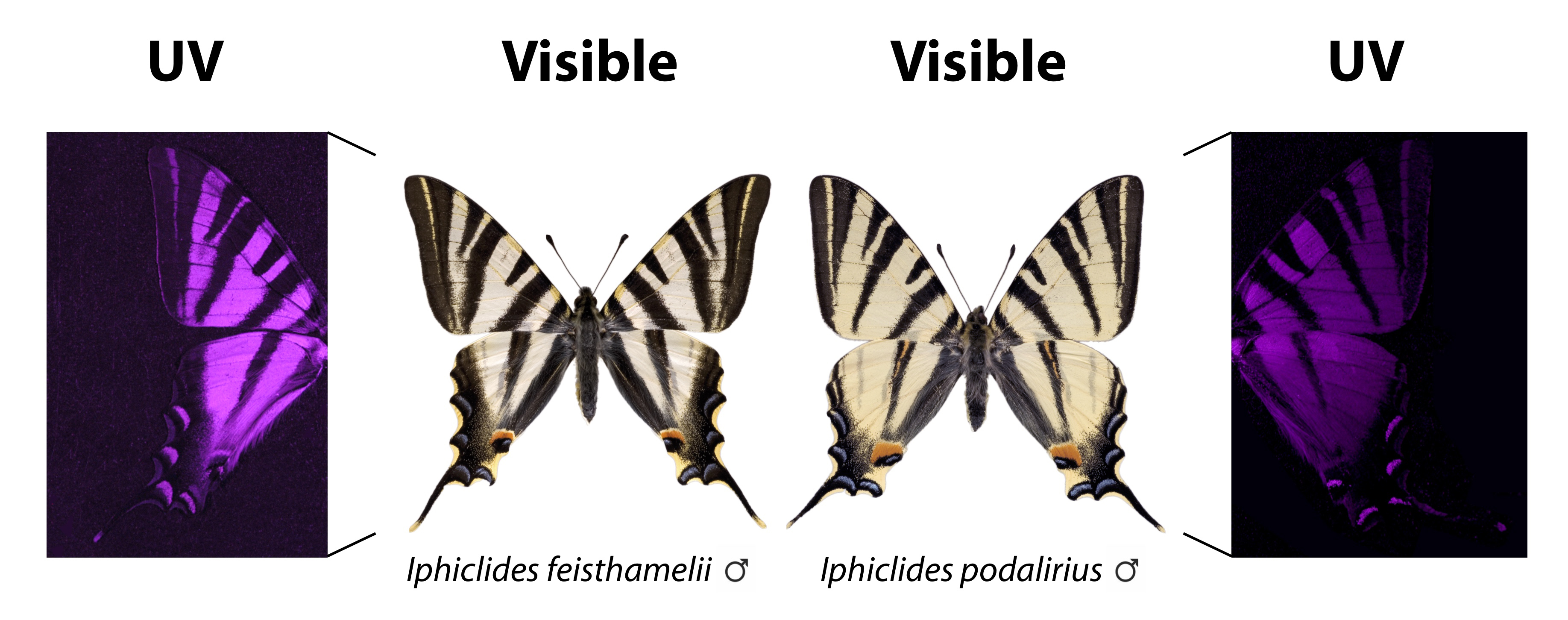UV light reveals new butterfly species
Science is full of SHEroes whose passion, work and creativity inspired Evolutionary Biologists of today.
As part of our commitment with society, the Institute of Evolutionary Biology (IBE, CSIC-UPF) wants to give credit and visibility to the achievements of female scientists in evolution.
To that aim, we launched the campaign #WhoisyourSHEro to share stories of women who had an impact in our researchers' scientific career through our social media and website.
The campaign keeps on moving as more and more women in evolution are inspiring the IBE community.
You can join the conversation through social media under the hashtag #WhoisyourSHEro.
With the collaboration of the Spanish Foundation for Science and Technology - Ministry of Science and Innovation.
 |
UV light reveals new butterfly species
The Scarce Swallowtail butterfly is split in two species, identical to the human eye but with very different males under UV light. Female butterflies differentiate and choose the males of their species thanks to their expanded vision beyond the human visible spectrum. The infection of a parasitic bacterium mediated a genetic transfer between both species, feeding a taxonomic confusion that has lasted for centuries. These two species could be used as a model to decipher the effects of parasitic bacteria on the evolution of insects.
 Researchers from the Institute of Evolutionary Biology (IBE) in Barcelona, a mixed centre of the Spanish National Research Council (CSIC) and the Pompeu Fabra University (UPF), has discovered that the scarce swallowtail is split in two species with males very different under ultraviolet light. The female butterflies, able to see beyond the visible, probably identify and choose the males of their species according to this colour difference. The taxonomic confusion is due to a genetic transfer between both species mediated by the bacterium Wolbachia. These two species could shed light on how parasitic bacteria affect the evolution of insects.
Researchers from the Institute of Evolutionary Biology (IBE) in Barcelona, a mixed centre of the Spanish National Research Council (CSIC) and the Pompeu Fabra University (UPF), has discovered that the scarce swallowtail is split in two species with males very different under ultraviolet light. The female butterflies, able to see beyond the visible, probably identify and choose the males of their species according to this colour difference. The taxonomic confusion is due to a genetic transfer between both species mediated by the bacterium Wolbachia. These two species could shed light on how parasitic bacteria affect the evolution of insects.
Two spectacular species that puzzled scientists for centuries
The Swallowtail butterflies are some of the biggest and most beautiful insects in Europe. Although they have attracted the attention of scientists and nature enthusiasts for centuries, the status of the Southern Scarce Swallowtail has remained contentious, either as a subspecies of the Scarce Swallowtail (Iphiclides podalirius) or as a different species (Iphiclides feisthamelii). While subtle morphological differences among the two have been documented, the first genetic studies showed no clear differentiation. Now a new study, led by Roger Vila, researcher at the Institute of Evolutionary Biology (CSIC-UPF) of Barcelona, confirms that the Southern Scarce Swallowtail butterfly and the Scarce Swallowtail are different species.
A key discovery: the ultraviolet reflectance of male wings
Researchers observed differences in the size and morphology of the reproductive organs of both butterflies, although the biggest difference was found in male wings. By means of ultraviolet (UV) photography, they discovered that male wings of both species reflect light in this area of the spectrum differently (the Southern Scarce Swallowtail butterfly very intensely and the Scarce Swallowtail poorly). This difference was revealing, as it is not detectable to the naked human eye but it is visible to butterflies, which can see in this area of the invisible spectrum. "As female butterflies are very demanding in the selection of partners and tend to accept only males of healthy appearance of their own species, the colours of the wings are key to male sexual attractiveness," explains Roger Vila, responsible for the study and principal investigator at IBE. This ability of butterflies to identify themselves in the ultraviolet would also allow them to communicate with each other in a "secret" way, avoiding possible predators without vision beyond the visible spectrum. "We are beginning to understand how butterflies perceive the world and we are humbled by their superpowers: they see more colours than us, they can detect polarized light and sense the magnetic north, not to mention their refined chemical detection system," adds Vila.
A parasitic bacterium explains the taxonomic confusion
The study shows that the parasitic bacterium called Wolbachia is responsible for this confusion between both species. This bacterium lives inside the cells of insects and, once there, it is transmitted maternally to the descendants, just like mitochondrial DNA (which is found in the mitochondria of cells). Vila's team has discovered that Wolbachia first infected the Scarce Swallowtail and then the infection was transmitted in a cross, next to the mitochondrial genome, to the sister species - the Southern Scarce Swallowtail. "Mitochondrial DNA transfer between the two species through the bacterial infection has confused the scientific community for many years, but the recent exhaustive DNA analysis together with the differences observed in the wings leave no doubt: they are two different species", concludes Roger Vila. This work points at these butterflies as a possible model for studying the effects of parasitic bacteria on the evolution of insects.
The project has been funded by the Spanish Agencia Estatal de Investigación and the European Community.
Reference article: Gaunet, A.*, Dincă, V.*, Dapporto, L.*, Montagud, S., Vodă, R., Schär, S., Badiane, A., Font, E. & Vila, R. (2019) Two consecutive Wolbachia-mediated mitochondrial introgressions obscure taxonomy in Palearctic swallowtail butterflies (Lepidoptera, Papilionidae). Zoologica Scripta (accepted) (*co-first authors).
